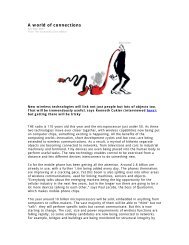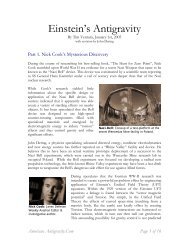Warp Drive Underwater - Signal Lake Venture Fund
Warp Drive Underwater - Signal Lake Venture Fund
Warp Drive Underwater - Signal Lake Venture Fund
You also want an ePaper? Increase the reach of your titles
YUMPU automatically turns print PDFs into web optimized ePapers that Google loves.
PHILIP HOWE<br />
Neutralizing Mines<br />
EVERYONE HAS SEEN action-movie heroes avoid fusillades<br />
of bullets by diving several feet underwater. The bullets ricochet<br />
away or expend their energy surprisingly rapidly as a result<br />
of drag and lateral hydrodynamic forces.<br />
When the Office of Naval Research was asked to find a<br />
cost-effective way to stop thousand-dollar surface mines<br />
from damaging or destroying multimillion-dollar ships, they<br />
turned to supercavitating projectiles. The result was RAMICS—<br />
the Rapid Airborne Mine Clearance System, which is being<br />
Most existing and anticipated autonomous supercavitating<br />
vehicles rely on rocket-type motors to generate<br />
the required thrust. But conventional rockets entail<br />
some serious drawbacks—limited range and declining<br />
thrust performance with the rise of pressure as depth<br />
increases. The first of these problems is being addressed<br />
with a new kind of high-energy-density power-plant<br />
technology; the second problem may be circumvented<br />
by using a special kind of supercavitating propeller<br />
screw technology.<br />
“Getting up to supercavitation speeds requires a lot<br />
of power,” says researcher Savchenko. “For maximum<br />
range with rockets, you need to burn high-energy-density<br />
fuels that provide the maximum specific impulse.”<br />
He estimates that a typical solid-rocket motor can<br />
achieve a maximum range of several tens of kilometers<br />
and a top speed of perhaps 200 meters per second. After<br />
considering propulsion systems based on diesel engines,<br />
electric motors, atomic power plants, high-speed<br />
diesels, and gas turbines, Savchenko concluded that<br />
“only high-efficiency gas turbines and jet propulsion<br />
systems burning metal fuels (aluminum, magnesium or<br />
lithium) and using outboard water as both the fuel oxidizer<br />
and coolant of the combustion products have<br />
The Science of War: Weapons<br />
developed for the U.S. Navy by a team led by Raytheon Naval<br />
& Maritime Integrated Systems in Portsmouth, R.I. Operating<br />
from helicopters, RAMICS will locate subsurface sea mines<br />
with an imaging blue-green lidar (light detection and ranging)<br />
system, calculate their exact position despite the bending of<br />
light by water refraction, and then shoot them with supercavitating<br />
rounds that travel stably in both air and water. The<br />
special projectiles contain charges that cause the deflagration,<br />
or moderated burning, of the mine’s explosives.<br />
LIDAR<br />
PROJECTILE TRAJECTORY ANTISHIP MINE<br />
real potential for propelling supercavitating vehicles to<br />
high velocities.”<br />
Aluminum, which is relatively cheap, is the most<br />
energetic of these metal fuels, producing a reaction<br />
temperature of up to 10,600 degrees Celsius. “One can<br />
accelerate the reaction by fluidizing [melting] the metal<br />
and using water vapor,” Savchenko explains. In one<br />
candidate power-plant design, the heat from the combustion<br />
chamber would be used to melt stored aluminum<br />
sheets at about 675 degrees C and to vaporize<br />
seawater as well. The resulting combustion products<br />
turn turbine-driven propeller screws.<br />
This type of system has already been developed in<br />
Russia, according to media reports there. The U.S. also<br />
has experience with these kinds of systems. Researchers<br />
at Penn State’s Applied Research Laboratory are operating<br />
an aluminum-burning “water ramjet” system,<br />
which was developed as an auxiliary power source for<br />
a naval surface ship.<br />
In the novel American design, powdered aluminum<br />
feeds into a whirlpool of seawater occurring in what is<br />
called a vortex combustor. The rapid rotation scrapes<br />
the particles together, grinding off the inert aluminum<br />
oxide film that covers them, which initiates an intense<br />
Copyright 2002 Scientific American, Inc.<br />
ANTIMINE<br />
PROJECTILE<br />
Supercavitating<br />
projectiles shot from<br />
above the ocean<br />
surface must fly<br />
stably in both air and<br />
water—a difficult<br />
engineering task.<br />
The RAMICS round<br />
( partially visible)<br />
was developed by<br />
C Tech Defense<br />
Corporation.<br />
SCIENTIFIC AMERICAN SPECIAL ONLINE ISSUE 35





